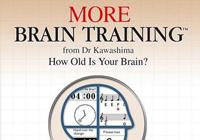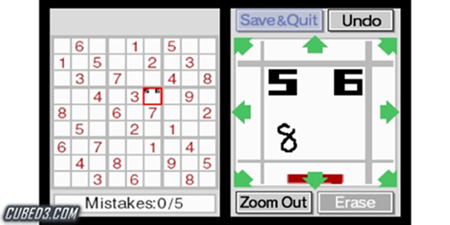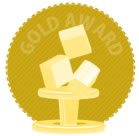More Brain Training from Dr. Kawashima: How Old is Your Brain? (Nintendo DS) Review
By Adam Riley  20.06.2007
20.06.2007

Nintendo has well and truly proven that its Touch! Generations series can transcend the East-West divide, with many games ending up more successful here in Europe than Japan. Between the likes of Big Brain Academy, 42 All-Time Classics, nintendogs, the recently released Picross and even English Training, us Europeans have most certainly changed our ideas about what to buy in a gaming 'emporium' and the potential audience has been expanded considerably. Now the next stage in the Brain Training programme is here. But does it work as well as its predecessor?
The first aspect you notice about More Brain Training is that the visuals are exactly the same as in the original game, which is no particularly bad thing as you do not exactly need fancy 3D graphics swirling around whilst you are desperately trying your best to concentrate on the various tasks you are faced with. In fact, so fond of the purposely block-shaped Kawashima-head have we become that it is pleasing to see his jovial mug back in all its 'glory', heartily chortling away on random occasions! The other point that is glaringly obvious is how the music has only been tweaked ever so slightly. Clearly the in-game challenges have no soundtrack, for fear of distracting your pre-frontal cortex, but the main menu tunes are basically the same as before, just with a few extra notes or changes in pitch thrown in to good effect. At least this means they retain the intellectually stimulating feel of the first game...

For the millions out there who have already played Dr. Kawashima's Brain Training already, you will most definitely be in familiar territory here as the layout and basic idea is the same. For any who are unsure what this is all about, though, the premise is that Professor Ryuta Kawashima of Japan is renowned for helping stimulate the prefrontal cortex of people's brains by using simple word and mathematical problems. He states that just like any other muscle in your body, if you exercise the brain on a regular basis, even just for ten minutes each day, it will become stronger, healthier and, most importantly, younger. Thus arose the concept of Brain Training: How Old is Your Brain?
How it works on the DS is that you start up the programme with the system being held on its side like a book and are encouraged to partake in several training sessions, before being put on the spot and having your brain age checked. There are eleven different training programmes to try out, but rather than unlock them all in one go, you are encouraged to come back everyday and do at least a little bit of training, which will earn you a stamp for that day on the in-game calendar. Obtain enough stamps and more tests become available. As for the Brain Age check itself, there are six tests that are randomly chosen each day (five if you choose the option where you cannot speak freely, such as in public places or the working environment).

But what of these tests – are they as stimulating as Dr. Kawashima insists? Well, yes they are actually. Here is a quick run-through of some of the earlier tests on offer. First up are number games such as Missing Symbols, Correct Change and Memory Addition. The first in that list sees you with a simple on-screen mathematical expression, such as 1 + 2 = 3. However, the + sign is missing, so you can just see 1 [space] 2 = 3 and must write the required symbol on the touch-screen. The second test listed shows you money on the bottom of the left screen, along with a digital figure above it. You must subtract that digital number from the money and express the answer in coins on the touch-screen by dragging the ‘correct change’ into the answer box. For example, you see a £5 note and need to take 1.00 away from it, all you need to do is drag the £1 coin into the answer box four times to give the right answer. As for Memory Addition, a number appears, for instance ‘9’, then quickly another number (say ‘1’) and a plus sign appears, with the 9 then being scrubbed out. By the time you have written the answer of ‘10’, another number has appeared and now the ‘1’ is frantically being scrubbed out by the computer. So, if you were writing and forgot about the ‘1’, you are then in trouble…so you need to write and keep an eye on the left-screen at the same time. Be sure to avoid letting your mind wander as that could quickly turn things into a complete disaster!
In terms of word games, there are things like Word Scramble, where jumbled letters spin around in a circle and you must figure out the word; Word Blend, where the game says two or three words simultaneously, leaving you to focus hard and pick out each word separately, writing the answer with the stylus; and Rock-Paper-Scissors, in which you see a hand shaped like one of those three objects and must say the correct answer out loud, depending on whether the request is for you to ‘Win’ or ‘Lose’. Confused? Well, say you see a ‘Rock’ fist and are told to lose; you would have to say ‘Scissors’ out loud. Get it? This works much better than the colours task from the first game, as the voice recognition appears to have been refined. Speaking of which, the handwriting recognition, sadly, is still the same. So be prepared to have to alter your writing style to suit the game in order to get the best results. But that can hardly be called a major negative point as it still does its job very well indeed.

Finally, before wrapping this up, it must be mentioned that there are also some other gems in More Brain Training, such as the Masterpiece Recital, where a piece of music is played to you with a cursor moving along the musical score and when it passes certain notes you must tap on the virtual piano keyboard in the right places. Other than that, Acrostics is another nice little addition, rather the task of having to draw objects simply from memory that was found in the first game. Here you are given a three-letter word and must write three separate words that actually describe it, but the tricky bit is that the first letter of each must be one of the letters from the original three letter word...Overall, everything just gels together so well and shows that the magic from the first game has definitely been replicated for this edition.
As for how long the game is going to last you...well, have you played the original? Remember how much time you were able to put into that one? In fact, I still dabble with it now and it was released last May! You need to remember that this game does not replace Brain Training, but complements it perfectly and with the incentive to keep playing in order to unlock other tests, plus the new selection of Sudoku puzzles and the ability to chart your progress against other friends and family, this will easily keep you going for another year and beyond.

Cubed3 Rating
Exceptional - Gold Award

Brain Training just got even better. Forget all the pretenders to the throne that have hit the shelves over the past twelve months as Nintendo and Dr. Kawashima truly, and rightfully, have the market sewn up in terms of quality. If you were a fan of the first brain programme then make sure you put down a pre-order for this now, as they are likely to sell out very fast on 29th June!

Brain Age 2: More Training in Minutes a Day
![]() 9/10
9/10
![]() 0
(0 Votes)
0
(0 Votes)
 Out now
Out now  Out now
Out now  Out now
Out now  Out now
Out now Comments
Comments are currently disabled

 Sign In
Sign In Game Details
Game Details Subscribe to this topic
Subscribe to this topic Features
Features






 Top
Top

